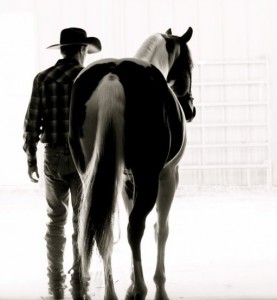 Training a horse can be really hard and really easy. It depends on how well you can communicate to the horse and how well you can read what the horse is thinking. If you can recognize the moment in which the horse is trying to work for you and reward him for it, it creates a trust and a learning progression that will develop a strong foundation in the horse’s training.
Training a horse can be really hard and really easy. It depends on how well you can communicate to the horse and how well you can read what the horse is thinking. If you can recognize the moment in which the horse is trying to work for you and reward him for it, it creates a trust and a learning progression that will develop a strong foundation in the horse’s training.
Let’s say you are working with a horse on handling his feet. You lean down and grasp the horse’s pastern and ask him to give it to you. The horse nervously shifts his weight, momentarily lifting the hoof, but steps back down on it immediately. At this point you can blindly blame the horse for being stubborn, or you can recognize the fact that the horse did indeed move that hoof and should be rewarded. A lot of folks will fail to understand that the horse tried to do as you wished. If you take this split-second opportunity to speak encouragingly to your horse, pet him a little, and let him rest for a moment before trying to lift his hoof again, you establish in his mind that he just did the desired action, even if he didn’t give his hoof to you for an extended amount of time. If you miss the opportunity, and keep working him right through it, the horse will possibly become more difficult to manage, moving away from you touching his feet or not lifting them at all…..because you failed to communicate to him when he tried to do the correct action. Giving the horse immediate release of pressure and praise at the correct moment will advance you miles ahead in training the horse to lift his hoof when you ask for it.
You might need to break down the lesson into smaller increments, if this helps you think through it in horse language. At first, moving the hoof at all is an accomplishment. Maybe just letting you touch the horse’s legs is an accomplishment. Every horse is an individual, and each one will respond differently. But build on what he knows, and make your goals realistic. If you can recognize the “try” and emphasize the right behavior with praise and rest as a reward, it will develop trust in a horse. Repeating the process will strengthen that bond and the horse will soon learn to give you his hoof and stand quietly.
This lesson applies when you are attempting anything new with a horse. Whether you’re trying to get your horse to cross a stream, pass a scary trail obstacle, stand still while you clip him, load in a trailer, learn to sidepass…it doesn’t matter what the lesson is, if it’s something new to a horse, you need to take baby steps and reward each time the horse tries for you. This lesson does not apply to a trained horse that already knows the procedure and is just acting balky. So know your horse, and listen to what he is saying—if he is acting out of fear or apprehension, ask for a try and reward it. If he is acting out of stubborness or rebellion, work him through it and make him do it so he doesn’t get the idea you’ll baby him along and let him rest when he isn’t fully obeying your cues.
But a lot of horse owners totally miss when their young horse is trying to obey and work them right on through it. Horses learn much better if they are given rest as a reward for even the slightest try at doing what they’re asked. Don’t use treats or grain as a reward! Rewarding a horse with treats will divert his attention from the actual lesson, but releasing all pressure, praising the horse, and letting him rest and think about what just happened will accomplish great strides in his learning. Next time you are asking a horse to do something, watch him closely and reward him at the slightest give in his demeanor. You will get a quicker response and a better relationship with your horse.

